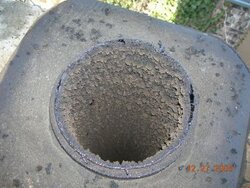Todd
Minister of Fire
Sounds like that grate could be the problem. That stove was designed to burn wood or coal and probably more tuned for coal since the air comes up from the bottom. Once you cut off the air and loaded it full, got her going good it was starved for air and gulped some down the chimney or through the seams (back puffing)



 I'm not completely nuts, well I guess that's still up for debate. At least someone else has experienced this type of thing. Thanks international5288. My symptoms don't exactly match your description, but I think that is just due to different stoves. My stove isn't very "auto" anything and I don't have any air control for the cat. My stove was built in 83, and I think they were just figuring out the best way to incorporate them into stoves. I know the later models of my stove do have an air control for the cat. I have experienced mini explosions so to speak when I've opened a door or air inlet during these occasions. All the smoke and gases ignite immediatly in the box making a puff sound, but strong enough to rattle the stove a bit.
I'm not completely nuts, well I guess that's still up for debate. At least someone else has experienced this type of thing. Thanks international5288. My symptoms don't exactly match your description, but I think that is just due to different stoves. My stove isn't very "auto" anything and I don't have any air control for the cat. My stove was built in 83, and I think they were just figuring out the best way to incorporate them into stoves. I know the later models of my stove do have an air control for the cat. I have experienced mini explosions so to speak when I've opened a door or air inlet during these occasions. All the smoke and gases ignite immediatly in the box making a puff sound, but strong enough to rattle the stove a bit.